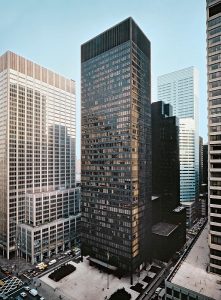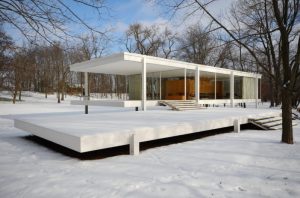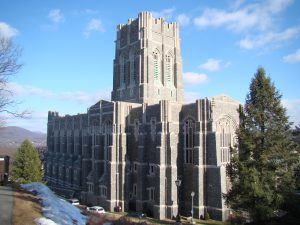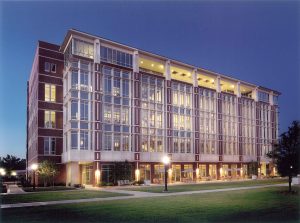Built in a wealthy neighborhood in the Czech Republic between 1928 and 1930, this structure appears to be way ahead of its time. It is said to be one of the pioneering prototypes of modernism in Europe and it is clear to see why. The three-story villa is situated on a slope of a hill and utilizes a sense of minimalism. Mies van der Rohe wanted to emphasize a functional utility, as in the Seagram Building, by expressing the external and structural elements. The use of floor to ceiling windows is a common theme among his works but at the time of its construction, it was a very unusual design. The cost of the construction, of course, was incredibly high, largely due to the use of expensive materials such as onyx, tropical woods, and marble, along with modern heating and ventilation systems. This house really impresses me because it is a design that I could see myself enjoying living in, and the fact that this was built in 1930 is just astonishing.
All posts by donald.b.albers
BLOG 7 – Donald Albers – Mies van der Rohe – Seagram Building
The Seagram Building is probably one of Mies van der Rohe’s most seen and visited buildings, largely due to its location in Midtown Manhattan. Mies van der Rohe was given an unlimited budget for the building from the Seagram’s heiress and therefore had complete control over the materials and design of the structure. The building’s use of articulating the structure externally greatly influenced the field of architecture. Van der Rohe believed that the building’s structural elements should be visible in order to better connect with the public. He did not believe in ornamenting the building and found the functional utility to be more beautiful. Having spent a good amount of time in Midtown Manhattan, I never knew this was built from a world-renowned architect, but I definitely remember this building by how much it stands out from the typical building in the city.
BLOG 6 – Donald Albers – Mies van der Rohe – Farnsworth House
The Farnsworth House is one of Mies van der Rohe’s most iconic designs and most studied projects that he ever started. Built between 1945 and 1951, this building was designed to be a weekend-retreat, having only a single room. This building is widely recognized as being an “international” style of architecture, which shares many attributes with modernism and modern architecture. Due to lawsuits and disagreements between the client and himself arising from an increase in the construction budget, van der Rohe never completed the inside, but it was later finished by a former employee of his. This design was incredibly modern, even in today’s standards, with its use of floor to ceiling windows. Today it remains a popular attraction to architectural students.
BLOG 5 – Donald Albers – Mies van der Rohe – Barcelona Pavilion
Ludwig Mies van der Rohe is one of the most influential architects of the 20th century and is credited with elevating one of the most popular forms of architecture today, modernism. This building is known as one of his most famous works, through its use of extravagant materials placed into a simple form. One of the interesting facts about this building was that due to severe time constraints, this structure had to be designed in less than a year. Additionally, as it was built in 1929, the main idea behind the building was to shine a new light on a democratic, culturally progressive, and prospering Germany after World War 1. One aspect in which one can see this concept is the floating roof and the completely open design.
West Point Chapel
The West Point Chapel just might be one of the most incredible buildings I’ve had the chance to explore. While I was a cadet at West Point for 2 years, I found the architecture extremely drab and somewhat depressing due to everything being built from the same gray stone. There was very little variation between the buildings, but the chapel, which was situated up the hill from the other buildings, had this castle-like appearance. While I didn’t go to any church services, I did always appreciate being able to look up from the parade ground and see this beautiful structure. Also, fun fact, the organ is the largest all-pipe organ, in a religious structure, in the world.
Devon Energy Hall
The Devon Energy Hall was the first building I ever got the chance to go inside at OU. I visited OU with my 8th-grade class in order to do a science event, and this building was the primary center for all the activities. As I did then, I still really enjoy the open layout on the ground floor and also on the top floor. The outside seating incorporated with lighting almost makes the building feel more inviting, and the top floor being open makes it feel like it is not an academic building. I am looking forward to taking classes in the building where I first got to experience OU.
Frank Lloyd Wright Montana
I visited this house because one of my cousins was able to book this place for her wedding. It’s located up near Missoula, Montana and it has a beautiful landscape; you can watch the deer and elk right outside your window. What was so interesting to me was how well the buildings meshed with the surrounding environment. Also, I was a little surprised that one of the most famous architects in the world would do a job that was this modest in the middle of Montana where it wouldn’t be seen by many people. I hope to go back there at some point and refresh my memory.
Arcadia Round Barn
The famous “Round Barn” can be found right in Arcadia, Oklahoma on Route 66. The building has been a tourist attraction for those driving on Route 66 since the 1920s, and similar to these tourists, I too find this structure extraordinary. The first time I drove on Route 66 when I was 10 and had just moved here, my parents pointed out the building and explained its significance. I thought it was incredible that someone had decided to build something like this over 100 years ago. From then on, I have driven by it often on my way to Pops or to the lake, and I imagine it will probably be around for quite some time.








